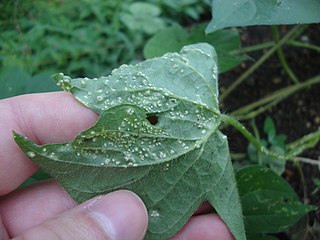
Amaranthus is a cosmopolitan group of more than 50 species which make up the genus of annual or short-lived perennial plants collectively known as amaranths. Some of the more well known names include "prostrate pigweed" and "love lies bleeding". Some amaranth species are cultivated as leaf vegetables, pseudocereals, and ornamental plants. Catkin-like cymes of densely packed flowers grow in summer or fall. Amaranth varies in flower, leaf, and stem color with a range of striking pigments from the spectrum of maroon to crimson and can grow longitudinally from 1 to 2.5 metres tall with a cylindrical, succulent, fibrous stem that is hollow with grooves and bracteoles when mature. There are approximately 75 species in the genus, 10 of which are dioecious and native to North America with the remaining 65 monoecious species endemic to every continent from tropical lowlands to the Himalayas. Members of this genus share many characteristics and uses with members of the closely related genus Celosia. Amaranth grain is collected from the genus. The leaves of some species are also eaten.

Rusts are fungal plant pathogens of the order Pucciniales causing plant fungal diseases.

The Oomycetes, or Oomycota, form a distinct phylogenetic lineage of fungus-like eukaryotic microorganisms within the Stramenopiles. They are filamentous and heterotrophic, and can reproduce both sexually and asexually. Sexual reproduction of an oospore is the result of contact between hyphae of male antheridia and female oogonia; these spores can overwinter and are known as resting spores. Asexual reproduction involves the formation of chlamydospores and sporangia, producing motile zoospores. Oomycetes occupy both saprophytic and pathogenic lifestyles, and include some of the most notorious pathogens of plants, causing devastating diseases such as late blight of potato and sudden oak death. One oomycete, the mycoparasite Pythium oligandrum, is used for biocontrol, attacking plant pathogenic fungi. The oomycetes are also often referred to as water molds, although the water-preferring nature which led to that name is not true of most species, which are terrestrial pathogens.

Amaranthaceae is a family of flowering plants commonly known as the amaranth family, in reference to its type genus Amaranthus. It includes the former goosefoot family Chenopodiaceae and contains about 165 genera and 2,040 species, making it the most species-rich lineage within its parent order, Caryophyllales.

Amaranthus cruentus is a flowering plant species that yields the nutritious staple amaranth grain. It is one of three Amaranthus species cultivated as a grain source, the other two being Amaranthus hypochondriacus and Amaranthus caudatus. It has several common names, including blood amaranth, red amaranth, purple amaranth, prince's feather, and Mexican grain amaranth.

Ulmus davidiana var. japonica, the Japanese elm, is one of the larger and more graceful Asiatic elms, endemic to much of continental northeast Asia and Japan, where it grows in swamp forest on young alluvial soils, although much of this habitat has now been lost to intensive rice cultivation.

Albugo candida, commonly known as white rust or white blister rust, is an obligate plant pathogen in the family Albuginaceae that infects Brassicaceae species. It has a relatively smaller genome than other oomycetes.

Hyaloperonospora brassicae, in the family Peronosporaceae, is a plant pathogen. It causes downy mildew of species of Brassica, Raphanus, Sinapis and probably other genera within the Brassicaceae. In the past, the cause of downy mildew in any plant in the family Brassicaceae was considered to be a single species Peronospora parasitica. However, this has recently been shown to be a complex of species with narrower host ranges, now classified in the genus Hyaloperonospora, for example Hyaloperonospora parasitica on the weed Capsella bursa-pastoris. From the perspective of plant pathology, Hyaloperonospora brassicae is now the name of the most important pathogen in this complex, attacking the major agricultural and horticultural Brassica species. Other significant Brassicaceous hosts are attacked by different species in the complex, e.g. horseradish by Hyaloperonospora cochleariae, wallflower by Hyaloperonospora cheiranthi.

Albugo ipomoeae-panduratae, or white rust, is an oomycete plant pathogen, although many discussions still treat it as a fungal organism. It causes leaf and stem lesions on various Ipomoea species, including cultivated morning glories and their relatives.
Albugo occidentalis, the causal agent of spinach white rust, is an oomycete plant pathogen, although some discussions still treat it as a fungal organism. Albugo occidentalis is one of the most important spinach diseases in North America, found throughout the United States east of the rocky mountains.

Pustula tragopogonis, the goatsbeard white rust, is an oomycete plant pathogen unrelated to fungal organisms.

Albugo is a genus of plant-parasitic oomycetes. Those are not true fungi (Eumycota), although many discussions of this organism still treat it as a fungus. The taxonomy of this genus is incomplete, but several species are plant pathogens. Albugo is one of three genera currently described in the family Albuginaceae, the taxonomy of many species is still in flux.

Albuginaceae is a family of oomycetes.

Lepidium oleraceum is a herb in the family Brassicaceae, endemic to New Zealand. Its English common name is Cook's scurvy grass; Māori names include nau, ngau, naunau and heketara.
White rust is a disease in plants caused by the oomycete Albugo candida or one of its close relatives. Plants susceptible to this disease generally include members of the Brassica family. White rust has been known to cause agricultural losses in fields cultivating members of this family including broccoli, cauliflower, and Indian mustard. Despite the name, it is not considered a true rust.
Albugo laibachii is a species of oomycete, whose genome has recently (2011) been sequenced. It is a plant pathogen of Arabidopsis thaliana. Albugo laibachii also causes the host plant to become more susceptible to other parasites, when it normally would be more resistant, wearing down the host plant's immune system.

Wilsoniana is a genus of plant-parasitic oomycetes segregated from Albugo. The name is in honor of the American mycologist G.W.Wilson
Frank Lincoln Stevens was an American mycologist and phytopathologist. He gained an international reputation as one of the preeminent mycologists.











